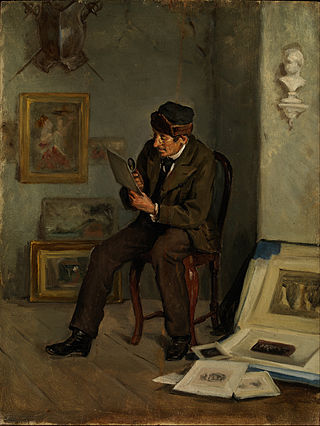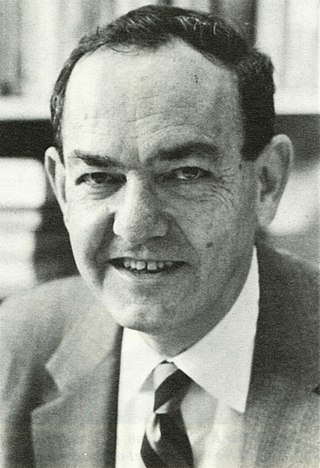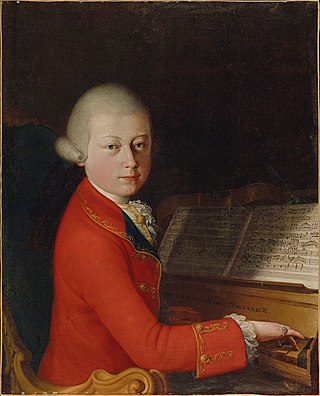Related Research Articles

Cognitive science is the interdisciplinary, scientific study of the mind and its processes. It examines the nature, the tasks, and the functions of cognition. Mental faculties of concern to cognitive scientists include language, perception, memory, attention, reasoning, and emotion; to understand these faculties, cognitive scientists borrow from fields such as linguistics, psychology, artificial intelligence, philosophy, neuroscience, and anthropology. The typical analysis of cognitive science spans many levels of organization, from learning and decision to logic and planning; from neural circuitry to modular brain organization. One of the fundamental concepts of cognitive science is that "thinking can best be understood in terms of representational structures in the mind and computational procedures that operate on those structures."
Cognitive psychology is the scientific study of mental processes such as attention, language use, memory, perception, problem solving, creativity, and reasoning.

An expert is somebody who has a broad and deep understanding and competence in terms of knowledge, skill and experience through practice and education in a particular field or area of study. Informally, an expert is someone widely recognized as a reliable source of technique or skill whose faculty for judging or deciding rightly, justly, or wisely is accorded authority and status by peers or the public in a specific well-distinguished domain. An expert, more generally, is a person with extensive knowledge or ability based on research, experience, or occupation and in a particular area of study. Experts are called in for advice on their respective subject, but they do not always agree on the particulars of a field of study. An expert can be believed, by virtue of credentials, training, education, profession, publication or experience, to have special knowledge of a subject beyond that of the average person, sufficient that others may officially rely upon the individual's opinion on that topic. Historically, an expert was referred to as a sage. The individual was usually a profound thinker distinguished for wisdom and sound judgment.

Herbert Alexander Simon was an American political scientist whose work also influenced the fields of computer science, economics, and cognitive psychology. His primary research interest was decision-making within organizations and he is best known for the theories of "bounded rationality" and "satisficing". He received the Nobel Memorial Prize in Economic Sciences in 1978 and the Turing Award in computer science in 1975. His research was noted for its interdisciplinary nature, spanning the fields of cognitive science, computer science, public administration, management, and political science. He was at Carnegie Mellon University for most of his career, from 1949 to 2001, where he helped found the Carnegie Mellon School of Computer Science, one of the first such departments in the world.

Cognition is the "mental action or process of acquiring knowledge and understanding through thought, experience, and the senses". It encompasses all aspects of intellectual functions and processes such as: perception, attention, thought, imagination, intelligence, the formation of knowledge, memory and working memory, judgment and evaluation, reasoning and computation, problem-solving and decision-making, comprehension and production of language. Cognitive processes use existing knowledge to discover new knowledge.

A child prodigy is a person under the age of ten who produces meaningful work in some domain at the level of an adult expert. The term is also applied more broadly to describe young people who are extraordinarily talented in some field.
"The Magical Number Seven, Plus or Minus Two: Some Limits on Our Capacity for Processing Information" is one of the most highly cited papers in psychology. It was written by the cognitive psychologist George A. Miller of Harvard University's Department of Psychology and published in 1956 in Psychological Review. It is often interpreted to argue that the number of objects an average human can hold in short-term memory is 7 ± 2. This has occasionally been referred to as Miller's law.
Soar is a cognitive architecture, originally created by John Laird, Allen Newell, and Paul Rosenbloom at Carnegie Mellon University.
In cognitive psychology, chunking is a process by which small individual pieces of a set of information are bound together to create a meaningful whole later on in memory. The chunks, by which the information is grouped, are meant to improve short-term retention of the material, thus bypassing the limited capacity of working memory and allowing the working memory to be more efficient. A chunk is a collection of basic units that are strongly associated with one another, and have been grouped together and stored in a person's memory. These chunks can be retrieved easily due to their coherent grouping. It is believed that individuals create higher-order cognitive representations of the items within the chunk. The items are more easily remembered as a group than as the individual items themselves. These chunks can be highly subjective because they rely on an individual's perceptions and past experiences, which are linked to the information set. The size of the chunks generally ranges from two to six items but often differs based on language and culture.
Computational cognition is the study of the computational basis of learning and inference by mathematical modeling, computer simulation, and behavioral experiments. In psychology, it is an approach which develops computational models based on experimental results. It seeks to understand the basis behind the human method of processing of information. Early on computational cognitive scientists sought to bring back and create a scientific form of Brentano's psychology.
Information processing theory is the approach to the study of cognitive development evolved out of the American experimental tradition in psychology. Developmental psychologists who adopt the information processing perspective account for mental development in terms of maturational changes in basic components of a child's mind. The theory is based on the idea that humans process the information they receive, rather than merely responding to stimuli. This perspective uses an analogy to consider how the mind works like a computer. In this way, the mind functions like a biological computer responsible for analyzing information from the environment. According to the standard information-processing model for mental development, the mind's machinery includes attention mechanisms for bringing information in, working memory for actively manipulating information, and long-term memory for passively holding information so that it can be used in the future. This theory addresses how as children grow, their brains likewise mature, leading to advances in their ability to process and respond to the information they received through their senses. The theory emphasizes a continuous pattern of development, in contrast with cognitive-developmental theorists such as Jean Piaget's theory of cognitive development that thought development occurs in stages at a time.
Lawrence W. Barsalou is an American psychologist and a cognitive scientist, currently working at the University of Glasgow.
In mental memory, storage is one of three fundamental stages along with encoding and retrieval. Memory is the process of storing and recalling information that was previously acquired. Storing refers to the process of placing newly acquired information into memory, which is modified in the brain for easier storage. Encoding this information makes the process of retrieval easier for the brain where it can be recalled and brought into conscious thinking. Modern memory psychology differentiates between the two distinct types of memory storage: short-term memory and long-term memory. Several models of memory have been proposed over the past century, some of them suggesting different relationships between short- and long-term memory to account for different ways of storing memory.
EPAM is a psychological theory of learning and memory implemented as a computer program. Originally designed by Herbert A. Simon and Edward Feigenbaum to simulate phenomena in verbal learning, it has been later adapted to account for data on the psychology of expertise and concept formation. It was influential in formalizing the concept of a chunk. In EPAM, learning consists in the growth of a discrimination network. EPAM was written in IPL/V.

Connectionist Learning with Adaptive Rule Induction On-line (CLARION) is a computational cognitive architecture that has been used to simulate many domains and tasks in cognitive psychology and social psychology, as well as implementing intelligent systems in artificial intelligence applications. An important feature of CLARION is the distinction between implicit and explicit processes and focusing on capturing the interaction between these two types of processes. The system was created by the research group led by Ron Sun.
Psi-theory, developed by Dietrich Dörner at the University of Bamberg, is a systemic psychological theory covering human action regulation, intention selection and emotion. It models the human mind as an information processing agent, controlled by a set of basic physiological, social and cognitive drives. Perceptual and cognitive processing are directed and modulated by these drives, which allow the autonomous establishment and pursuit of goals in an open environment.

Embodied cognition is the concept suggesting that many features of cognition are shaped by the state and capacities of the organism. The cognitive features include a wide spectrum of cognitive functions, such as perception biases, memory recall, comprehension and high-level mental constructs and performance on various cognitive tasks. The bodily aspects involve the motor system, the perceptual system, the bodily interactions with the environment (situatedness), and the assumptions about the world built the functional structure of organism's brain and body.

Fernand Gobet is a cognitive scientist and a cognitive psychologist, currently Professor of Cognitive Psychology at the London School of Economics. His research interests focus on the study of cognition, especially in the areas of cognitive architectures, perception, intuition, problem solving, learning and decision making. He has developed the CHREST cognitive architecture, an acronym for Chunk Hierarchy and REtrieval STructures, which is a complete architecture for the processes of learning and perception used by humans. He is a chess International Master, and played numerous times for the Swiss national team. He was co-editor of the Swiss Chess Review from 1981 to 1989. His Elo rating is 2400.

Spatial ability or visuo-spatial ability is the capacity to understand, reason, and remember the visual and spatial relations among objects or space.
References
- 1 2 3 "CHREST - Chessprogramming wiki". www.chessprogramming.org. Retrieved 2022-05-12.
- 1 2 3 4 5 Lane, Peter C. R.; Gobet, Fernand; Smith, Richard Ll. (2009), "Attention Mechanisms in the CHREST Cognitive Architecture", Attention in Cognitive Systems, Berlin, Heidelberg: Springer Berlin Heidelberg, pp. 183–196, doi:10.1007/978-3-642-00582-4_14, hdl: 2299/3368 , ISBN 978-3-642-00581-7 , retrieved 2022-05-12
- 1 2 3 4 5 6 Lane, David M.; Chang, Yu-Hsuan A. (April 2018). "Chess knowledge predicts chess memory even after controlling for chess experience: Evidence for the role of high-level processes". Memory & Cognition. 46 (3): 337–348. doi: 10.3758/s13421-017-0768-2 . ISSN 0090-502X. PMID 29101550. S2CID 207695064.
- 1 2 3 4 5 6 7 8 9 10 11 12 13 14 15 16 Smith, Richard; Gobet, Fernand; Lane, Peter (2007). "An Investigation into the Effect of Ageing on Expert Memory with CHREST" (PDF). Proceedings of the United Kingdom Workshop on Computational Intelligence.
- 1 2 3 4 Gobet, Fernand; Lane, Peter (2010). "The CHREST Architecture of Cognition: The Role of Perception in General Intelligence". Proceedings of the 3d Conference on Artificial General Intelligence (AGI-10). Paris, France: Atlantis Press. doi: 10.2991/agi.2010.20 . ISBN 9789078677369.
- 1 2 Iran-Nejad, Asghar; Winsler, Adam (2000). "Bartlett's Schema Theory and Modern Accounts of Learning and Remembering". The Journal of Mind and Behavior. 21 (1/2): 5–35. ISSN 0271-0137. JSTOR 43853902.
- ↑ Miller, George A. (March 1956). "The magical number seven, plus or minus two: Some limits on our capacity for processing information". Psychological Review. 63 (2): 81–97. doi:10.1037/h0043158. hdl: 11858/00-001M-0000-002C-4646-B . ISSN 1939-1471. PMID 13310704. S2CID 15654531.
- 1 2 3 4 5 6 7 Simon, Herbert A; Gilmartin, Kevin (July 1973). "A simulation of memory for chess positions". Cognitive Psychology. 5 (1): 29–46. doi:10.1016/0010-0285(73)90024-8. ISSN 0010-0285.
- 1 2 3 Lane, Peter; Gobet, Fernand (2012), Bach, Joscha; Goertzel, Ben; Iklé, Matthew (eds.), "CHREST Models of Implicit Learning and Board Game Interpretation", Artificial General Intelligence, vol. 7716, Berlin, Heidelberg: Springer Berlin Heidelberg, pp. 148–157, doi:10.1007/978-3-642-35506-6_16, ISBN 978-3-642-35505-9 , retrieved 2022-05-12
- 1 2 3 4 Simon, Herbert Alexander (13 August 2019). The sciences of the artificial. MIT Press. ISBN 978-0-262-53753-7. OCLC 1158593167.
- ↑ Langley, Pat; Laird, John E.; Rogers, Seth (June 2009). "Cognitive architectures: Research issues and challenges". Cognitive Systems Research. 10 (2): 141–160. doi:10.1016/j.cogsys.2006.07.004. ISSN 1389-0417. S2CID 14457207.
- 1 2 3 4 Woollett, Katherine; Maguire, Eleanor A. (2010-12-01). "The effect of navigational expertise on wayfinding in new environments". Journal of Environmental Psychology. 30 (4): 565–573. doi:10.1016/j.jenvp.2010.03.003. ISSN 0272-4944. PMC 2989443 . PMID 21151353.
- 1 2 3 4 5 6 Lehrer, Jonah. "The Cognitive Cost Of Expertise". Wired. ISSN 1059-1028 . Retrieved 2022-05-26.
- 1 2 3 4 Maguire, Eleanor A.; Gadian, David G.; Johnsrude, Ingrid S.; Good, Catriona D.; Ashburner, John; Frackowiak, Richard S. J.; Frith, Christopher D. (2000-04-11). "Navigation-related structural change in the hippocampi of taxi drivers". Proceedings of the National Academy of Sciences. 97 (8): 4398–4403. Bibcode:2000PNAS...97.4398M. doi: 10.1073/pnas.070039597 . ISSN 0027-8424. PMC 18253 . PMID 10716738.
- 1 2 3 4 Ensmenger, Nathan (2012). "Is chess the drosophila of artificial intelligence? A social history of an algorithm". Social Studies of Science. 42 (1): 5–30. doi:10.1177/0306312711424596. ISSN 0306-3127. JSTOR 23210226. PMID 22530382. S2CID 968033.
- ↑ Franchi, Stefano (2005-04-01). "Chess, Games, and Flies". Essays in Philosophy. 6 (1): 85–114. doi:10.5840/eip20056119.
- ↑ Chase, William G.; Simon, Herbert A. (1973-01-01), Chase, WILLIAM G. (ed.), "THE MIND'S EYE IN CHESS", Visual Information Processing, Academic Press, pp. 215–281, ISBN 978-0-12-170150-5 , retrieved 2022-05-26
- ↑ Groot, Adriaan D. de (24 July 2014). Thought and Choice in Chess. Walter de Gruyter GmbH & Co KG. ISBN 978-3-11-080064-7. OCLC 1089408027.
- ↑ "CHREST | CHREST". www.chrest.info. Retrieved 2022-05-26.
- 1 2 Gobet, F. (1993). "A computer model of chess memory".
{{cite journal}}: Cite journal requires|journal=(help) - 1 2 3 Charness, N. (March 1981). "Aging and skilled problem solving". Journal of Experimental Psychology. General. 110 (1): 21–38. doi:10.1037/0096-3445.110.1.21. ISSN 0096-3445. PMID 6453184.
- 1 2 Gobet, Fernand (2012). Moves in mind : the psychology of board games. Psychology Press. ISBN 978-0-415-65565-1. OCLC 972001994.
- 1 2 Nickerson, Charlotte (December 6, 2021). "The Role of a Schema in Psychology". SimplyPsychology. Retrieved 2022-05-26.